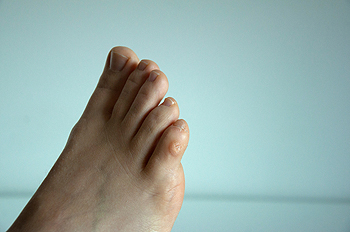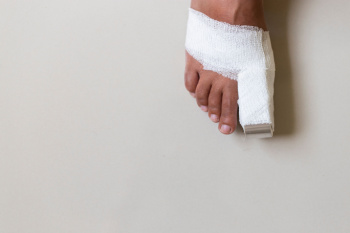 Ankle sprains are injuries that occur when the ligaments that support the ankle stretch beyond their limits or tear. These injuries are often caused by twisting the ankle during physical activities, such as sports or even walking on uneven surfaces. Treatment for ankle sprains ranges from conservative to more intensive approaches, depending on the severity of the sprain. Initial treatment for mild sprains typically includes rest and elevation to reduce swelling and pain. More severe sprains may require immobilization with a brace or cast to allow the ligaments to heal properly. Certain stretches may be recommended to restore ankle strength, flexibility, and balance, and prevent future sprains. In cases where the ligament damage is extensive and stability is compromised, surgical intervention may be considered to repair the ligaments. If you have sprained your ankle, it is suggested that you promptly schedule an appointment with a podiatrist to get the right treatment.
Ankle sprains are injuries that occur when the ligaments that support the ankle stretch beyond their limits or tear. These injuries are often caused by twisting the ankle during physical activities, such as sports or even walking on uneven surfaces. Treatment for ankle sprains ranges from conservative to more intensive approaches, depending on the severity of the sprain. Initial treatment for mild sprains typically includes rest and elevation to reduce swelling and pain. More severe sprains may require immobilization with a brace or cast to allow the ligaments to heal properly. Certain stretches may be recommended to restore ankle strength, flexibility, and balance, and prevent future sprains. In cases where the ligament damage is extensive and stability is compromised, surgical intervention may be considered to repair the ligaments. If you have sprained your ankle, it is suggested that you promptly schedule an appointment with a podiatrist to get the right treatment.
Although ankle sprains are common, they aren’t always minor injuries. If you need your ankle injury looked at, contact Dr. Kenneth Donovan from Advanced Care Foot and Ankle. Our doctor can provide the care you need to keep you pain-free and on your feet.
How Does an Ankle Sprain Occur?
Ankle sprains are the result of a tear in the ligaments within the ankle. These injuries may happen when you make a rapid shifting movement while your foot is planted. A less common way to sprain your ankle is when your ankle rolls inward while your foot turns outward.
What Are the Symptoms?
- Pain at the sight of the tear
- Bruising/Swelling
- Ankle area is tender to touch
- In severe cases, may hear/feel something tear
- Skin discoloration
Preventing a Sprain
- Wearing appropriate shoes for the occasion
- Stretching before exercises and sports
- Knowing your limits
Treatment of a Sprain
In many cases, the RICE method (Rest, Ice, Compression, and Elevate) is used to treat ankle sprains. However, you should see a podiatrist to see which treatment option would work best with your injury. In severe cases, surgery may be required.
It is important to ask your doctor about rehab options after you receive treatment for your injury. Stretching, strength training, and balance exercises may help the ankle heal while also preventing further injury.
If you have any questions, please feel free to contact one of our offices located in Warren, Livingston, and Toms River, NJ . We offer the newest diagnostic and treatment technologies for all your foot care needs.

Corns on the feet are small, yet bothersome, skin formations that can cause significant pain if left untreated. Foot corns, which are composed of layers of dead skin cells, typically appear as thick, circular, raised areas of skin. They commonly develop on, near, or between the toes, below the toenail bed, or on the sole of the feet. The three primary types of foot corns are hard corns, soft corns, and seed corns. Regardless of their type, foot corns can cause discomfort, pain, and a burning sensation, particularly when wearing shoes or walking barefoot. Foot corns develop from excessive pressure or friction on the foot. Causes include wearing tight or ill-fitting shoes, prolonged standing, and walking or running barefoot. It's a good idea to address foot corns promptly and effectively to prevent complications. A podiatrist can offer personalized treatment options, including professional corn removal techniques and recommendations for footwear modifications. If you are experiencing the discomfort of corns on the foot, it is suggested that you schedule an appointment with a podiatrist to determine the type of corn and its proper treatment.
Corns can make walking very painful and should be treated immediately. If you have questions regarding your feet and ankles, contact Dr. Kenneth Donovan of Advanced Care Foot and Ankle. Our doctor will treat your foot and ankle needs.
Corns: What Are They? And How Do You Get Rid of Them?
Corns are thickened areas on the skin that can become painful. They are caused by excessive pressure and friction on the skin. Corns press into the deeper layers of the skin and are usually round in shape.
Ways to Prevent Corns
There are many ways to get rid of painful corns such as:
- Wearing properly fitting shoes that have been measured by a professional
- Wearing shoes that are not sharply pointed or have high heels
- Wearing only shoes that offer support
Treating Corns
Although most corns slowly disappear when the friction or pressure stops, this isn’t always the case. Consult with your podiatrist to determine the best treatment option for your case of corns.
If you have any questions please feel free to contact one of our offices located in Warren, Livingston, and Toms River, NJ . We offer the newest diagnostic and treatment technologies for all your foot and ankle needs.

A surgical procedure aimed at relieving pain from bone spurs on the top of the big toe is called a cheilectomy. The pain is the result of arthritis that also causes stiffness in the big toe, termed hallux rigidus. Typically considered after non-surgical interventions, a cheilectomy involves the careful removal of bone spurs to alleviate discomfort and improve range of motion. Whether performed under general or local anesthesia, the procedure usually allows for a same-day operation. Following surgery, treatment often starts with gentle toe movements and stretching exercises to prevent stiffness. The recovery period typically spans six to eight weeks. While individual recovery time may vary, the primary goal of restoring function and alleviating pain are the focus. If you have persistent pain and limited mobility in your big toe, it is suggested that you schedule an appointment with a podiatrist for an exam, diagnosis, and personalized treatment plan, which may include surgery.
Foot surgery is sometimes necessary to treat a foot ailment. To learn more, contact Dr. Kenneth Donovan of Advanced Care Foot and Ankle. Our doctor will assist you with all of your foot and ankle needs.
When Is Surgery Necessary?
Foot and ankle surgery is generally reserved for cases in which less invasive, conservative procedures have failed to alleviate the problem. Some of the cases in which surgery may be necessary include:
- Removing foot deformities like bunions and bone spurs
- Severe arthritis that has caused bone issues
- Cosmetic reconstruction
What Types of Surgery Are There?
The type of surgery you receive will depend on the nature of the problem you have. Some of the possible surgeries include:
- Bunionectomy for painful bunions
- Surgical fusion for realignment of bones
- Neuropathy decompression surgery to treat nerve damage
Benefits of Surgery
Although surgery is usually a last resort, it can provide more complete pain relief compared to non-surgical methods and may allow you to finally resume full activity.
Surgical techniques have also become increasingly sophisticated. Techniques like endoscopic surgery allow for smaller incisions and faster recovery times.
If you have any questions please feel free to contact one of our offices located in Warren, Livingston, and Toms River, NJ . We offer the newest diagnostic and treatment technologies for all your foot and ankle needs.

